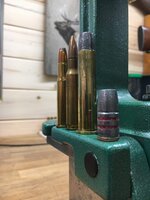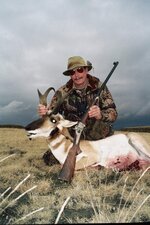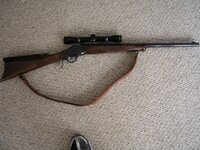Silver Supporter
Bronze Supporter
- Messages
- 4,210
- Reactions
- 6,918
I do not own a .458 American. But my best friend (since high school) does, and I have shot it quite a bit. I DO own a Siamese Mauser conversion to .45-70 (and have shot it quite a bit). If I had been aware of the American, I might never have bought the Mauser.
The American holds some "advantages" against the old war-horse when considering these cartridges in a bolt gun. Firstly is simplification of the "build": Acquire a short bolt action (first advantage: the American fits in a much smaller bread box), open the bolt face to standard belted magnum, acquire a barrel, and minor feed rail work gets it all running. If you start with a short Magnum action (think .350 Rem Mag), you save on opening the bolt face AND rail work. The Siamese conversion is somewhat more involved, especially when your short action came with sporter wood already, drilled and tapped already, nice swing safety already, etc., etc., etc. My friend built his American on a short-action 700, topped it with a Leupold 1.5-5x and it is a VERY tidy and VERY powerful package of artillery.
As to ballistics and loading, The two cartridges are nearly twins, with any difference being much less than the rather small difference between them (loaded to full-tilt boogie) and the .458. Ackley shows in his book (from the American) a 300g bullet at 2500fps (but Ackley data needs to be "interpreted" in numerous cases). More down to earth, he shows the 405g to be capable of 2050fps. Lets keep in mind that powders are now at least of more variety and probably of more capability than in Parker's day. (IMR3031 is still a favorite for running the .45-70 at speed). Orygun's explorations with RL-7 may be a good example of something that could improve over the old stalwarts.
I have a small collection of "dream" cartridges over my loading bench (dummys that I have constructed, or examples provided by friends of their favorites). The .458 American is in that gang. It just makes so much absolute sense.
The American holds some "advantages" against the old war-horse when considering these cartridges in a bolt gun. Firstly is simplification of the "build": Acquire a short bolt action (first advantage: the American fits in a much smaller bread box), open the bolt face to standard belted magnum, acquire a barrel, and minor feed rail work gets it all running. If you start with a short Magnum action (think .350 Rem Mag), you save on opening the bolt face AND rail work. The Siamese conversion is somewhat more involved, especially when your short action came with sporter wood already, drilled and tapped already, nice swing safety already, etc., etc., etc. My friend built his American on a short-action 700, topped it with a Leupold 1.5-5x and it is a VERY tidy and VERY powerful package of artillery.
As to ballistics and loading, The two cartridges are nearly twins, with any difference being much less than the rather small difference between them (loaded to full-tilt boogie) and the .458. Ackley shows in his book (from the American) a 300g bullet at 2500fps (but Ackley data needs to be "interpreted" in numerous cases). More down to earth, he shows the 405g to be capable of 2050fps. Lets keep in mind that powders are now at least of more variety and probably of more capability than in Parker's day. (IMR3031 is still a favorite for running the .45-70 at speed). Orygun's explorations with RL-7 may be a good example of something that could improve over the old stalwarts.
I have a small collection of "dream" cartridges over my loading bench (dummys that I have constructed, or examples provided by friends of their favorites). The .458 American is in that gang. It just makes so much absolute sense.














